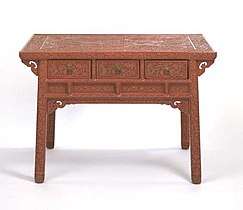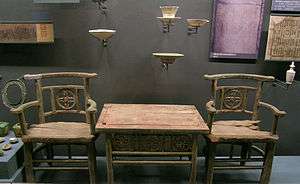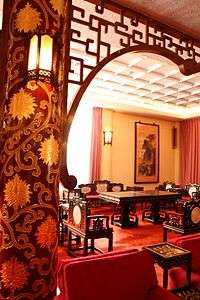Chinese furniture
The forms of Chinese furniture evolved along three distinct lineages which dates back to 1000 BC,[1] based on frame and panel, yoke and rack (based on post and rail seen in architecture) and bamboo construction techniques. Chinese home furniture evolved independently of Western furniture into many similar forms including chairs, tables, stools, cupboards, cabinets, beds and sofas. Until about the 10th century CE the Chinese sat on mats or low platforms using low tables, in typical Asian style, but then gradually moved to using high tables with chairs.[2]


Chinese furniture is mostly in plain polished wood, but from at least the Song dynasty the most luxurious pieces often used lacquer to cover the whole or parts of the visible areas. All the various sub-techniques of Chinese lacquerware can be found on furniture, and become increasingly affordable down the social scale, and so widely used, from about the Ming dynasty onwards. Carved lacquer furniture was at first only affordable by the imperial family or the extremely rich, but by the 19th century was merely very expensive, and mostly found in smaller pieces or as decorated areas on larger ones. It was especially popular on screens, which were common in China. Lacquer inlaid with mother of pearl was especially a technique used on furniture.[3]
Chinese furniture is usually light where possible, anticipating Europe by several centuries in this respect. Practical fittings in metal such as hinges, lock plates, drawer handles and protective plates at edges or feet are used, and often given considerable emphasis, but compared to classic fine European furniture purely decorative metal mounts were rare. From the Qing dynasty furniture made for export, mostly to Europe, became a distinct style, generally made in rather different shapes to suit the destination markets and highly decorated in lacquer and other techniques.[4]
Chinese furniture for sitting or lying on was very often used with cushions, but textiles and upholstery are not, until very late historical periods, incorporated into the piece itself in the Western manner. Openwork in carved wood or other techniques is very typical for practical purposes such as chair-backs, and also for decoration. The Ming period is regarded as the "golden age" of Chinese furniture, though very few examples of earlier pieces survive. Ming styles have largely set the style for furniture in traditional Chinese style in subsequent periods, though as in other areas of Chinese art, the 18th and 19th centuries saw increasing prosperity used for sometimes excessively elaborated pieces, as wider groups in society were able to imitate court styles.[5]
Cultural context
What is now considered the Chinese aesthetic had its origins in China as far back as 1500–1000 BC. The furniture present in some of the artwork from that early period shows woven mats on elevated floors, sometimes accompanied by arm rests, providing seating accompanied by low tables. In this early period both unadorned and intricately engraved and painted pieces were already developing.[6] High chairs, usually single ones, had existed as status symbols, effectively thrones, since at least the Eastern Zhou period (771–256 BCE), but were not used with tables at the same level.[7]
Buddhism, entering China around AD 200, brought with it the idea of (the Buddha) sitting upon a raised platform instead of simply mats. The platform was adopted as an honorific seat for special guests and dignitaries or officials. Longer versions were then used for reclining as well, which eventually evolved into the bed and daybed. Taller versions evolved into higher tables as well. The folding stool also proliferated similarly, after it was adapted from designs developed by nomadic tribes to the North and West, who used them for both their convenience and light weight in many applications such as mounting horses. Later, woven hourglass-shaped stools evolved; a design still in use today throughout China.
Some of the styles now widely regarded as Chinese began appearing more prominently in the Tang dynasty (618–907 AD). It is here that evidence of early versions of the round and yoke back chairs are found, generally used by the elite. By the next two Dynasties (the Northern and Southern Song) the use of varying types of furniture, including chairs, benches, and stools was common throughout Chinese society. Two particular developments were recessed legs and waisted tables. Newer and more complex designs were generally limited to official and higher class use.
It was from this basis that more modern Chinese furniture developed its distinguishing characteristics. Use of thick lacquer finish and detailed engraving and painted decoration as well as pragmatic design elements would continue to flourish. Significant foreign design influence would not be felt until increased contact with the West began in the 19th century, due to efforts on the part of the ruling elite to limit trade.
During the Ming and Qing dynasties previous bans on imports were lifted, allowing for larger quantities and varieties of woods to flood in from other parts of Asia. The use of denser wood led to much finer work, including more elaborate joinery. A Ming Imperial table entirely covered in carved lacquer, now in London, is one of the finest survivals of the period.
Four categories
Chinese furniture traditionally consisted of four distinct categories, all formed by the mid Qing dynasty, but each with its own unique characteristics.[8]
- Beijing category (京式家具): characterized by its simple build, directly developed from Ming Dynasty furnitures.
- Guangzhou category (广式家具): incorporating western influence, fully formed in the 19th century but dating back to at least 17th century.[9] Characterized by the adoptation of Baroque and Rococo artistic styles, use of native timbers in the Lingnan region, and the decorative mounting of marble and the shells of shellfish.
- Shanghai category (海式家具): characterized by its decorative carving and carved lacquer.
- Suzhou category (苏式家具): opposite to the Beijing category, characterized by its elaborate decoration, developed from early Qing Dynasty furniture.
Material
Classic Chinese furniture is typically made of a class of hardwoods, known collectively as "rosewood" (紅木, literally "red wood"). These woods are denser than water, fine grained, and high in oils and resins. These properties make them dimensionally stable, hardwearing, rot and insect resistant, and when new, highly fragrant. The density and toughness of the wood also allows furniture to be built without the use of glue and nail, but rather constructed from joinery and doweling alone. According to the Chinese industry standards the woods are grouped into eight classes:[10][11]
| Name | Chinese | Plant Genus | Description |
|---|---|---|---|
| Huali wood | 花黎木 | Pterocarpus | Woods typically from P. cambodianus, P. dalbergioides, P. erinaceus, P. indicus, P. macarocarpus, P. pedatus, and P. marsupium. This wood is known commercially in the West as "padauk". |
| Zitan wood | 紫檀木 | Dalbergia | Woods from Dalbergia nigra, a burgundy-black wood that oxidizes into a purple-black colour. Highly valued
Edit to this information. Zitan is not the same as Dalbergia Nigra rosewood, which is commonly known as Brazilian rosewood. Zitan is in the Petrocarpus family, specifically, Pterocarpus Santalinus. Commonly known as Purple sandalwood, which is somewhat of an inaccurate name. From Wang Shixiang, Classic Chinese Furniture. Joint Publishing. 1985. |
| Hong suanzhi wood | 紅酸枝木 | Reddish coloured woods that have a sour/acrid smell when freshly cut. The woods are typically from D. bariensis, D. cearensis, D. ochinchinensis, D. frulescensvar, D. granadillo, D. oliveri, D. retusa | |
| Hei suanzhi wood | 黑酸枝木 | Dark coloured woods that have a sour/acrid smell when freshly cut. The woods are typically from D. cultrate, D. fusca, D. latifolia, D. louvelii, D. melanoxylon, D. nigra, D. spruceana, and D. stevensonii | |
| Xiangzhi wood | 香枝木 | The wood from Dalbergia odorifera and known commonly by the name "Huanghua li" (黄花梨, literally yellow flowered pear) or "Jiangxiang huangtan" (降香黄檀, literally Fragrant yellow hardwood). This is one of the most valued and traditionally used hardwoods for Chinese furniture before its overharvesting from Chinese domestic sources. | |
| Wu/Yinchen wood | 烏木 / 陰沉木 | Diospyros | Typically refers to woods from Diospyros crassiflora, Diospyros ebenum, Diospyros pilosanthera, and D. poncei, which are known as ebony in the west. Name is sometimes mistaken applied to Dalbergia nigra. |
| Tiaowen wu wood | 條紋烏木 | Woods from trees of genus Diospyros with vivid dark and light striations. Principally Diospyros blancoi, Diospyros celebica and Diospyros melanoxylon. | |
| Jichi wood | 雞翅木 | Millettia and Other genus | Woods which have a finely patterned, high contrast grain that is similar to the feathers of certain birds, such as chickens and partridges. The wood is taken typically from Millettia laurentii (非洲崖豆木), Millettia leucantha (白花崖豆木), Ormosia hosiei(相思木), and either Senna siamea or Mesua ferrea (鐵力木) [12] but also from a wide variety of genus and species including, Terminalia tomentosa, Diplotropis purpurea, Hymenolobium excelsum, Andira inermis, and Steculit oblonga. |
Furniture and carving made from these woods are typically referred to, in the market, as "hongmu furniture" (紅木家具, literally "rosewood furniture"). Due to overlogging for the said furniture, most of the species are either threatened or endangered.
Construction

Construction of traditional wooden Chinese furniture is based primarily of solid wood pieces connected solely using woodworking joints, and rarely using glue or metallic nails. The reason was that the nails and glues used did not stand up well to the vastly fluctuating temperatures and humid weather conditions in most of Central and South-East Asia.[13] Further, the oily and resinous woods used in Chinese furniture generally do not glue well, even when pre-cleaned with modern industrial solvents.
Platform construction is based on box designs and uses frame-and-panel construction in simple form during earlier periods evolving into more and more modified forms in later periods. While earlier pieces show full frame-and-panel construction techniques, different parts of the construction were modified through the centuries to produce diverse looking pieces which still share the same basic construction. First the panel, originally complete, is subject to cut-out sections, followed by further reduction to what may appear to be simply decorative brackets. Further refinement of the same pattern lead the shape of the decorative brackets being incorporated into the shape of the surrounding frame and simultaneously the two mitered vertical pieces comprising a corner become one solid piece. Pieces start to have small cross-pieces attached to the bottom of the feet rather than a frame that is equal on all sides and finally, with evolution of the complex woodworking joints that allow it, the cross-pieces are removed entirely, leaving a modern table with 3-way mitered corners. Unlike European-derived styles, table designs based on this style will nearly always contain a frame-in-panel top, the panel serving as the tabletop center and the frame sometimes also serving as what would be rails on a European table. Cabinets in this style have a top that does not protrude beyond the sides or front. The critical element in almost all pieces of this type is the mitered joints, especially the 3-way mitered joining of the leg and two horizontal pieces at each corner.
The Yoke and Rack construction differs critically in the way that the legs of the piece are joined to the horizontal portion (be it tabletop, seat or cabinet carcass) using a type of wedged mortise-and-tenon joint where the end grain of the leg is visible as a circle in the frame of the tabletop. The cross-pieces (stretchers in the western equivalent) are joined through mortise-and-tenon joinery as well. The legs and stretchers are commonly round rather than square or curvilinear. The simplest pieces are simply four splayed legs attached to a solid top, but more complicated pieces contain decorative brackets, drawers and metal latches. Cabinets in this style typically have an overhanging top similar to western-style cabinetry.
Bamboo construction style, although historically rooted in pieces made from bamboo, later saw many pieces made from hardwood with patterning to imitate the look of bamboo, or simply in the style of previous pieces made from bamboo. The construction is more similar to the Yoke and Rack style with some apparent crossover.
Notes
- Ecke, G. "Chinese Domestic Furniture in Photographs and Measured Drawings" pp. XV-XXXIII, Dover Publications, Inc., 1986
- Grove
- Grove
- Grove
- Grove
- Grove
- Traditional Categories of Chinese furnitures
- 廣式家具與嶺南文化
- "红木宝贝", 乡土, CCTV1, 2010-09-01
- 国家标准红木分类, 北京秋翁堂古典家具有限公司, 2010-06-20
- 美丽的头冠之后——鸡翅木 Archived 2013-07-28 at Archive.today
- Huntley, Michael (20 January 2009), "Michael Huntley demystifies the furniture making techniques of Chinese craftsmen prior to 1900", Wood Worker's Institute, GMC Publications
References
- Ecke, Gustav (1986). Chinese domestic furniture in photographs and measured drawings. Dover Publications. ISBN 0486251713.CS1 maint: ref=harv (link)
- "Grove", Handler, Sarah, Oxford Art Online, "China, XII. Furniture", Subscription required
- Handler, Sarah (2001). Austere luminosity of Chinese classical furniture. Berkeley: University of California Press. ISBN 0520214846.CS1 maint: ref=harv (link)
External links
- Classical Chinese Furniture: Information Cybercenter for the Collector and Scholar. Includes images of datable furniture, explanations of joinery and construction, a lengthy bibliographical section.